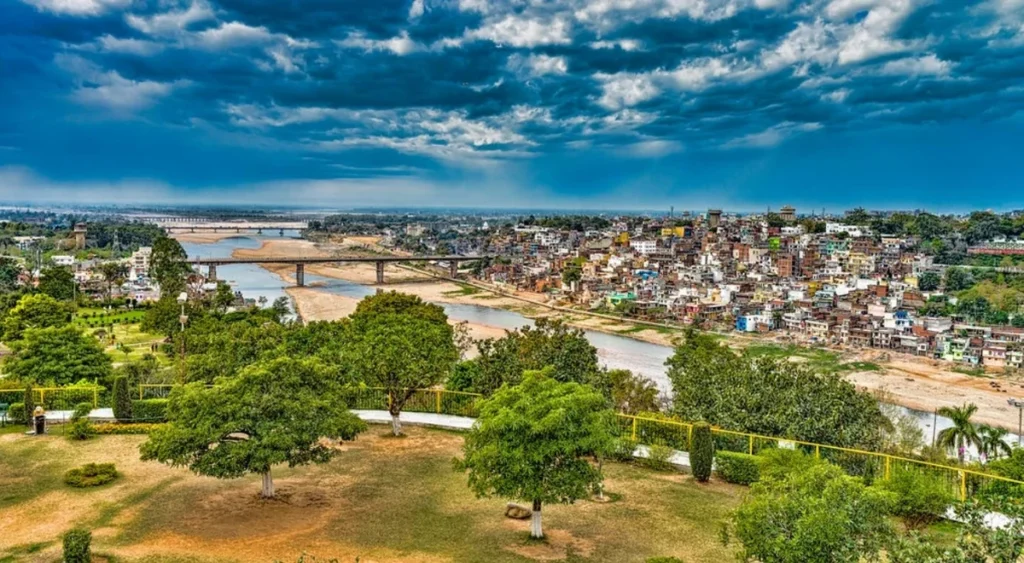“Explore Jammu District, the gateway to paradise. Discover rich heritage, scenic landscapes, spiritual sites, and vibrant culture in this enchanting region.”

Jammu District: A Melting Pot of Culture, History, and Natural Beauty
Nestled in the northernmost part of India, Jammu District stands as a testament to the rich tapestry of culture, history, and natural beauty that the region is known for. Spread over an area of approximately 2,890 square kilometers, the district is a captivating blend of ancient traditions, modern developments, and breathtaking landscapes.
With a history dating back millennia, Jammu District has been a significant center of power and culture. The city of Jammu, its headquarters, holds a prominent place in the chronicles of India’s past. The historic Mubarak Mandi Palace, once the seat of the Dogra rulers, is a stunning architectural marvel that reflects the grandeur of the bygone era. The Amar Mahal Palace, another architectural gem, now houses a museum that showcases artifacts and artworks from the region’s history.
One of the most revered religious sites, the Vaishno Devi Temple, draws millions of pilgrims every year. Perched atop the Trikuta Hills, the temple is dedicated to Goddess Vaishno Devi and involves a strenuous uphill trek that tests the devotees’ faith and determination. Another spiritual attraction is the Raghunath Temple complex, an important religious hub with a collection of shrines dedicated to various deities.
Jammu’s cultural mosaic is a result of its diverse population, comprising Dogras, Kashmiris, Punjabis, and other ethnic groups. This amalgamation is evident in the region’s festivals, music, dance, and cuisine. The annual Jammu Mahotsav celebrates this cultural diversity, featuring traditional performances, handicraft exhibitions, and delectable local dishes.
Beyond its cultural significance, Jammu District boasts breathtaking natural landscapes. The picturesque Patnitop hill station, enveloped by thick forests of pine and cedar, offers respite from the scorching summer heat. The Sanasar meadows, with their lush green expanses, are a haven for adventure enthusiasts, offering opportunities for paragliding, trekking, and camping.
The district is traversed by the Tawi River, whose banks have been transformed into well-maintained gardens and parks. The Bagh-e-Bahu Garden is a serene oasis in the heart of the city, while the Peer Kho Cave Temple, located in the vicinity, offers a unique spiritual experience within its natural caverns.
Jammu’s strategic location makes it a gateway to the state of Jammu and Kashmir. The iconic Jammu-Srinagar National Highway connects the district to the capital city of Srinagar, winding through breathtaking landscapes, including the famous Jawahar Tunnel that cuts through the Pir Panjal mountain range.
In recent years, Jammu District has seen infrastructural developments that have boosted its connectivity and economy. The growth of industries like tourism, handicrafts, and trade has contributed to the region’s prosperity. However, the administration and residents have worked hard to maintain the district’s cultural and environmental heritage, ensuring that progress is sustainable and respectful of tradition.
Famous Places Near by Jammu District
Jammu District is home to a plethora of famous places that offer a blend of history, spirituality, and natural beauty. Some of the standout destinations include:
Vaishno Devi Temple: A renowned pilgrimage site atop Trikuta Hills, this temple draws millions of devotees annually. The uphill trek and the shrine’s spiritual aura make it a significant religious destination.
Mubarak Mandi Palace: A historic palace complex in Jammu city, it was the seat of the Dogra rulers. Its stunning architecture and blend of Rajasthani, Mughal, and European styles make it a captivating attraction.
Amar Mahal Palace: This palace turned museum showcases artifacts and artworks from Jammu’s history. Its unique architecture and scenic location overlooking the Tawi River add to its allure.
Raghunath Temple: A significant religious complex housing multiple shrines dedicated to different deities. Its imposing structure and intricate carvings make it a prominent landmark.
Patnitop: A charming hill station known for its scenic beauty and adventure activities like trekking and paragliding. The cool climate and lush surroundings offer a refreshing escape.
Bagh-e-Bahu Garden: A well-maintained garden along the Tawi River, offering a peaceful retreat with walking paths, fountains, and a view of the Bahu Fort.
Peer Kho Cave Temple: A unique temple located within natural caves, offering a tranquil space for meditation and worship.
Jammu Old City: The heart of Jammu, this area is a maze of narrow streets, bustling bazaars, and ancient temples. It provides a glimpse into the district’s cultural heritage.
Sanasar: A meadow surrounded by pine forests, known for its scenic beauty and adventure sports like paragliding and camping.
Ranbireshwar Temple: Dedicated to Lord Shiva, this temple houses a massive Shiva Lingam and attracts devotees with its religious significance.
Ranbir Canal: An engineering marvel that brings water from the Chenab River to irrigate the region’s fields. It offers a serene environment for leisurely walks.
Mahamaya Temple: Located on a small hill overlooking the Tawi River, this temple offers panoramic views of the city and surrounding areas.
These famous places in Jammu District provide a diverse range of experiences, from religious devotion to historical exploration and nature appreciation. Each site adds its unique charm to the district’s overall appeal, making it a destination worth exploring for both locals and tourists alike.